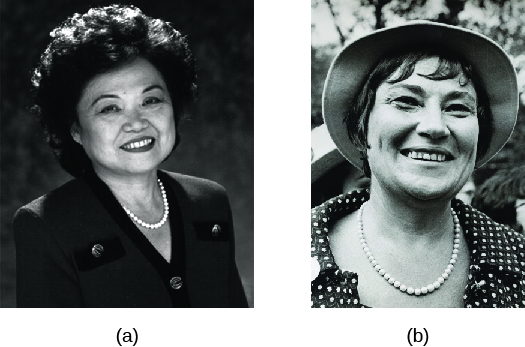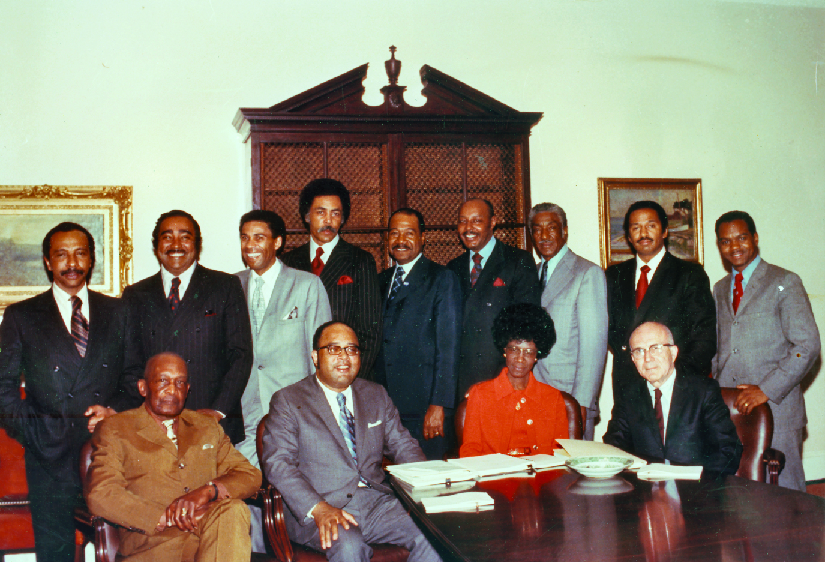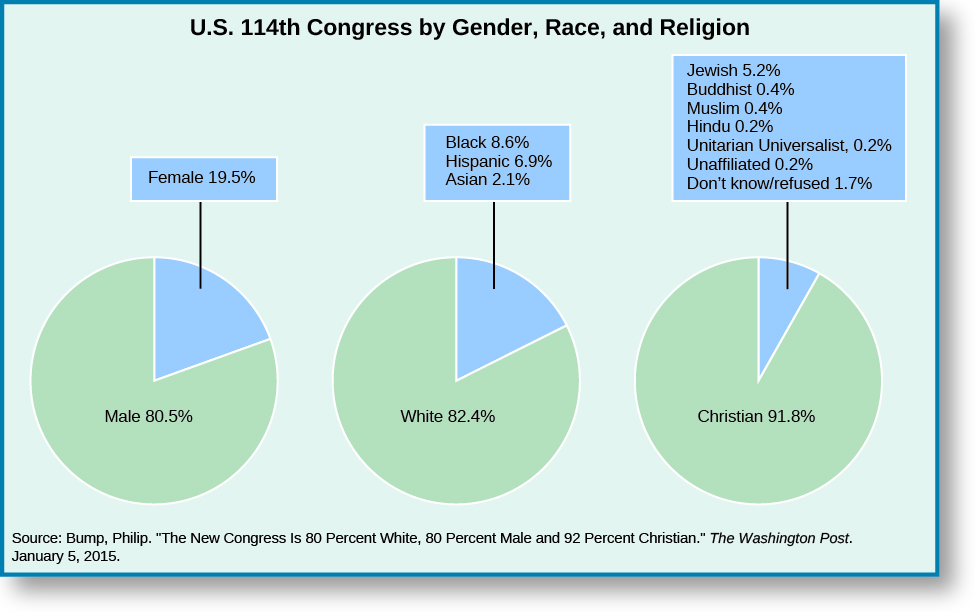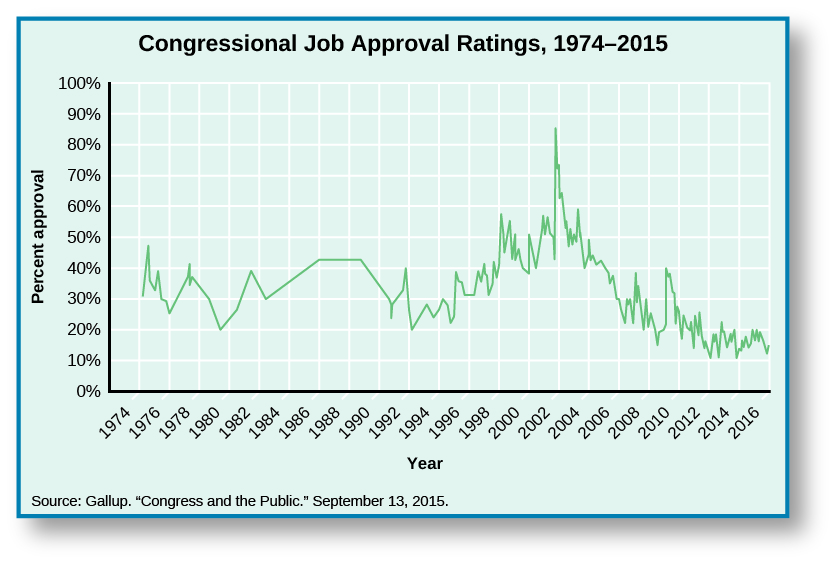Chapter 11: Congress
Congressional Representation
Learning Objectives
By the end of this section, you will be able to:
- Explain the basics of representation
- Describe the extent to which Congress as a body represents the U.S. population
- Explain the concept of collective representation
- Describe the forces that influence congressional approval ratings
The tension between local and national politics described in the previous section is essentially a struggle between interpretations of representation. Representation is a complex concept. It can mean paying careful attention to the concerns of constituents, understanding that representatives must act as they see fit based on what they feel best for the constituency, or relying on the particular ethnic, racial, or gender diversity of those in office. In this section, we will explore three different models of representation and the concept of descriptive representation. We will look at the way members of Congress navigate the challenging terrain of representation as they serve, and all the many predictable and unpredictable consequences of the decisions they make.
TYPES OF REPRESENTATION: LOOKING OUT FOR CONSTITUENTS
By definition and title, senators and House members are representatives. This means they are intended to be drawn from local populations around the country so they can speak for and make decisions for those local populations, their constituents, while serving in their respective legislative houses. That is, representation refers to an elected leader’s looking out for his or her constituents while carrying out the duties of the office.[1]
Theoretically, the process of constituents voting regularly and reaching out to their representatives helps these congresspersons better represent them. It is considered a given by some in representative democracies that representatives will seldom ignore the wishes of constituents, especially on salient issues that directly affect the district or state. In reality, the job of representing in Congress is often quite complicated, and elected leaders do not always know where their constituents stand. Nor do constituents always agree on everything. Navigating their sometimes contradictory demands and balancing them with the demands of the party, powerful interest groups, ideological concerns, the legislative body, their own personal beliefs, and the country as a whole can be a complicated and frustrating process for representatives.
Traditionally, representatives have seen their role as that of a delegate, a trustee, or someone attempting to balance the two. A representative who sees him- or herself as a delegate believes he or she is empowered merely to enact the wishes of constituents. Delegates must employ some means to identify the views of their constituents and then vote accordingly. They are not permitted the liberty of employing their own reason and judgment while acting as representatives in Congress. This is the delegate model of representation.
In contrast, a representative who understands their role to be that of a trustee believes he or she is entrusted by the constituents with the power to use good judgment to make decisions on the constituents’ behalf. In the words of the eighteenth-century British philosopher Edmund Burke, who championed the trustee model of representation, “Parliament is not a congress of ambassadors from different and hostile interests . . . [it is rather] a deliberative assembly of one nation, with one interest, that of the whole.”[2]
In the modern setting, trustee representatives will look to party consensus, party leadership, powerful interests, the member’s own personal views, and national trends to better identify the voting choices they should make.
Understandably, few if any representatives adhere strictly to one model or the other. Instead, most find themselves attempting to balance the important principles embedded in each. Political scientists call this the politico model of representation. In it, members of Congress act as either trustee or delegate based on rational political calculations about who is best served, the constituency or the nation.
For example, every representative, regardless of party or conservative versus liberal leanings, must remain firm in support of some ideologies and resistant to others. On the political right, an issue that demands support might be gun rights; on the left, it might be a woman’s right to an abortion. For votes related to such issues, representatives will likely pursue a delegate approach. For other issues, especially complex questions the public at large has little patience for, such as subtle economic reforms, representatives will tend to follow a trustee approach. This is not to say their decisions on these issues run contrary to public opinion. Rather, it merely means they are not acutely aware of or cannot adequately measure the extent to which their constituents support or reject the proposals at hand. It could also mean that the issue is not salient to their constituents. Congress works on hundreds of different issues each year, and constituents are likely not aware of the particulars of most of them.
DESCRIPTIVE REPRESENTATION IN CONGRESS
In some cases, representation can seem to have very little to do with the substantive issues representatives in Congress tend to debate. Instead, proper representation for some is rooted in the racial, ethnic, socioeconomic, gender, and sexual identity of the representatives themselves. This form of representation is called descriptive representation.
At one time, there was relatively little concern about descriptive representation in Congress. A major reason is that until well into the twentieth century, white men of European background constituted an overwhelming majority of the voting population. African Americans were routinely deprived of the opportunity to participate in democracy, and Hispanics and other minority groups were fairly insignificant in number and excluded by the states. While women in many western states could vote sooner, all women were not able to exercise their right to vote nationwide until passage of the Nineteenth Amendment in 1920, and they began to make up more than 5 percent of either chamber only in the 1990s.
Many advances in women’s rights have been the result of women’s greater engagement in politics and representation in the halls of government, especially since the founding of the National Organization for Women in 1966 and the National Women’s Political Caucus (NWPC) in 1971. The NWPC was formed by Bella Abzug ((Figure)), Gloria Steinem, Shirley Chisholm, and other leading feminists to encourage women’s participation in political parties, elect women to office, and raise money for their campaigns. For example, Patsy Mink (D-HI) ((Figure)), the first Asian American woman elected to Congress, was the coauthor of the Education Amendments Act of 1972, Title IX of which prohibits sex discrimination in education. Mink had been interested in fighting discrimination in education since her youth, when she opposed racial segregation in campus housing while a student at the University of Nebraska. She went to law school after being denied admission to medical school because of her gender. Like Mink, many other women sought and won political office, many with the help of the NWPC. Today, EMILY’s List, a PAC founded in 1985 to help elect pro-choice Democratic women to office, plays a major role in fundraising for female candidates. In the 2012 general election, 80 percent of the candidates endorsed by EMILY’s List won a seat.[3]

Figure 1. Patsy Mink (a), a Japanese American from Hawaii, was the first Asian American woman elected to the House of Representatives. In her successful 1970 congressional campaign, Bella Abzug (b) declared, “This woman’s place is in the House… the House of Representatives!”
In the wake of the Civil Rights Movement, African American representatives also began to enter Congress in increasing numbers. In 1971, to better represent their interests, these representatives founded the Congressional Black Caucus (CBC), an organization that grew out of a Democratic select committee formed in 1969. Founding members of the CBC include John Conyers (D-MI), currently the longest-serving member of the House of Representatives, Charles Rangel (D-NY), and Shirley Chisholm, a founder of the NWPC and the first African American woman to be elected to the House of Representatives ((Figure)).

Figure 2. This photo shows the founding members of the Congressional Black Caucus, which at the time of its founding in 1971 had only thirteen members. Currently, forty-six African Americans serve in Congress.
In recent decades, Congress has become much more descriptively representative of the United States. The 114th Congress, which began in January 2015, had a historically large percentage of racial and ethnic minorities. African Americans made up the largest percentage, with forty-eight members, while Latinos accounted for thirty-two members, up from nineteen just over a decade before.[4]
Yet, demographically speaking, Congress as a whole is still a long way from where the country is and remains largely white, male, and wealthy. For example, although more than half the U.S. population is female, only 20 percent of Congress is. Congress is also overwhelmingly Christian ((Figure)).

Figure 3. The diversity of the country is not reflected in the U.S. Congress, whose current membership is approximately 80 percent male, 82 percent white, and 92 percent Christian.
REPRESENTING CONSTITUENTS
Ethnic, racial, gender, or ideological identity aside, it is a representative’s actions in Congress that ultimately reflect his or her understanding of representation. Congress members’ most important function as lawmakers is writing, supporting, and passing bills. And as representatives of their constituents, they are charged with addressing those constituents’ interests. Historically, this job has included what some have affectionately called “bringing home the bacon” but what many (usually those outside the district in question) call pork-barrel politics. As a term and a practice, pork-barrel politics—federal spending on projects designed to benefit a particular district or set of constituents—has been around since the nineteenth century, when barrels of salt pork were both a sign of wealth and a system of reward. While pork-barrel politics are often deplored during election campaigns, and earmarks—funds appropriated for specific projects—are no longer permitted in Congress (see feature box below), legislative control of local appropriations nevertheless still exists. In more formal language, allocation, or the influencing of the national budget in ways that help the district or state, can mean securing funds for a specific district’s project like an airport, or getting tax breaks for certain types of agriculture or manufacturing.
|
Language and Metaphor The language and metaphors of war and violence are common in politics. Candidates routinely “smell blood in the water,” “battle for delegates,” go “head-to-head,” “cripple” their opponent, and “make heads roll.” But references to actual violence aren’t the only metaphorical devices commonly used in politics. Another is mentions of food. Powerful speakers frequently “throw red meat to the crowds;” careful politicians prefer to stick to “meat-and-potato issues;” and representatives are frequently encouraged by their constituents to “bring home the bacon.” And the way members of Congress typically “bring home the bacon” is often described with another agricultural metaphor, the “earmark.” In ranching, an earmark is a small cut on the ear of a cow or other animal to denote ownership. Similarly, in Congress, an earmark is a mark in a bill that directs some of the bill’s funds to be spent on specific projects or for specific tax exemptions. Since the 1980s, the earmark has become a common vehicle for sending money to various projects around the country. Many a road, hospital, and airport can trace its origins back to a few skillfully drafted earmarks. Relatively few people outside Congress had ever heard of the term before the 2008 presidential election, when Republican nominee Senator John McCain touted his career-long refusal to use the earmark as a testament to his commitment to reforming spending habits in Washington.[5] McCain’s criticism of the earmark as a form of corruption cast a shadow over a previously common legislative practice. As the country sank into recession and Congress tried to use spending bills to stimulate the economy, the public grew more acutely aware of its earmarking habits. Congresspersons then were eager to distance themselves from the practice. In fact, the use of earmarks to encourage Republicans to help pass health care reform actually made the bill less popular with the public. In 2011, after Republicans took over the House, they outlawed earmarks. But with deadlocks and stalemates becoming more common, some quiet voices have begun asking for a return to the practice. They argue that Congress works because representatives can satisfy their responsibilities to their constituents by making deals. The earmarks are those deals. By taking them away, Congress has hampered its own ability to “bring home the bacon.” Are earmarks a vital part of legislating or a corrupt practice that was rightly jettisoned? Pick a cause or industry, and investigate whether any earmarks ever favored it, or research the way earmarks have hurt or helped your state or district, and decide for yourself. Follow-up activity: Find out where your congressional representative stands on the ban on earmarks and write to support or dissuade him or her. |
Such budgetary allocations aren’t always looked upon favorably by constituents. Consider, for example, the passage of the ACA in 2010. The desire for comprehensive universal health care had been a driving position of the Democrats since at least the 1960s. During the 2008 campaign, that desire was so great among both Democrats and Republicans that both parties put forth plans. When the Democrats took control of Congress and the presidency in 2009, they quickly began putting together their plan. Soon, however, the politics grew complex, and the proposed plan became very contentious for the Republican Party.
Nevertheless, the desire to make good on a decades-old political promise compelled Democrats to do everything in their power to pass something. They offered sympathetic members of the Republican Party valuable budgetary concessions; they attempted to include allocations they hoped the opposition might feel compelled to support; and they drafted the bill in a purposely complex manner to avoid future challenges. These efforts, however, had the opposite effect. The Republican Party’s constituency interpreted the allocations as bribery and the bill as inherently flawed, and felt it should be scrapped entirely. The more Democrats dug in, the more frustrated the Republicans became ((Figure)).

Figure 4. In 2009, the extended debates and legislative maneuvering in Congress over the proposed health care reform bill triggered a firestorm of disapproval from the Republicans and protests from their supporters. In many cases, hyperbole ruled the day. (credit: “dbking”/Flickr)
The Republican opposition, which took control of the House during the 2010 midterm elections, promised constituents they would repeal the law. Their attempts were complicated, however, by the fact that Democrats still held the Senate and the presidency. Yet, the desire to represent the interests of their constituents compelled Republicans to use another tool at their disposal, the symbolic vote. During the 112th and 113th Congresses, Republicans voted more than sixty times to either repeal or severely limit the reach of the law. They understood these efforts had little to no chance of ever making it to the president’s desk. And if they did, he would certainly have vetoed them. But it was important for these representatives to demonstrate to their constituents that they understood their wishes and were willing to act on them.
Historically, representatives have been able to balance their role as members of a national legislative body with their role as representatives of a smaller community. The Obamacare fight, however, gave a boost to the growing concern that the power structure in Washington divides representatives from the needs of their constituency.[6]
This has exerted pressure on representatives to the extent that some now pursue a more straightforward delegate approach to representation. Indeed, following the 2010 election, a handful of Republicans began living in their offices in Washington, convinced that by not establishing a residence in Washington, they would appear closer to their constituents at home.[7]
COLLECTIVE REPRESENTATION AND CONGRESSIONAL APPROVAL
The concept of collective representation describes the relationship between Congress and the United States as a whole. That is, it considers whether the institution itself represents the American people, not just whether a particular member of Congress represents his or her district. Predictably, it is far more difficult for Congress to maintain a level of collective representation than it is for individual members of Congress to represent their own constituents. Not only is Congress a mixture of different ideologies, interests, and party affiliations, but the collective constituency of the United States has an even-greater level of diversity. Nor is it a solution to attempt to match the diversity of opinions and interests in the United States with those in Congress. Indeed, such an attempt would likely make it more difficult for Congress to maintain collective representation. Its rules and procedures require Congress to use flexibility, bargaining, and concessions. Yet, it is this flexibility and these concessions, which many now interpret as corruption, that tend to engender the high public disapproval ratings experienced by Congress.
After many years of deadlocks and bickering on Capitol Hill, the national perception of Congress is near an all-time low. According to Gallup polls, Congress has a stunningly poor approval rating of about 16 percent. This is unusual even for a body that has rarely enjoyed a high approval rating. For example, for nearly two decades following the Watergate scandal in the early 1970s, the national approval rating of Congress hovered between 30 and 40 percent.[8]
Yet, incumbent reelections have remained largely unaffected. The reason has to do with the remarkable ability of many in the United States to separate their distaste for Congress from their appreciation for their own representative. Paradoxically, this tendency to hate the group but love one’s own representative actually perpetuates the problem of poor congressional approval ratings. The reason is that it blunts voters’ natural desire to replace those in power who are earning such low approval ratings.
As decades of polling indicate, few events push congressional approval ratings above 50 percent. Indeed, when the ratings are graphed, the two noticeable peaks are at 57 percent in 1998 and 84 percent in 2001 ((Figure)). In 1998, according to Gallup polling, the rise in approval accompanied a similar rise in other mood measures, including President Bill Clinton’s approval ratings and general satisfaction with the state of the country and the economy. In 2001, approval spiked after the September 11 terrorist attacks and the Bush administration launched the “War on Terror,” sending troops first to Afghanistan and later to Iraq. War has the power to bring majorities of voters to view their Congress and president in an overwhelmingly positive way.[9]

Figure 5. Congress’s job approval rating reached a high of 84 percent in October 2001 following the 9/11 terrorist attacks. It has declined fairly steadily ever since, reaching a low of 9 percent in November 2013, just after the federal government shutdown in the previous month.
Nevertheless, all things being equal, citizens tend to rate Congress more highly when things get done and more poorly when things do not get done. For example, during the first half of President Obama’s first term, Congress’s approval rating reached a relative high of about 40 percent. Both houses were dominated by members of the president’s own party, and many people were eager for Congress to take action to end the deep recession and begin to repair the economy. Millions were suffering economically, out of work, or losing their jobs, and the idea that Congress was busy passing large stimulus packages, working on finance reform, and grilling unpopular bank CEOs and financial titans appealed to many. Approval began to fade as the Republican Party slowed the wheels of Congress during the tumultuous debates over Obamacare and reached a low of 9 percent following the federal government shutdown in October 2013.
One of the events that began the approval rating’s downward trend was Congress’s divisive debate over national deficits. A deficit is what results when Congress spends more than it has available. It then conducts additional deficit spending by increasing the national debt. Many modern economists contend that during periods of economic decline, the nation should run deficits, because additional government spending has a stimulative effect that can help restart a sluggish economy. Despite this benefit, voters rarely appreciate deficits. They see Congress as spending wastefully during a time when they themselves are cutting costs to get by.
The disconnect between the common public perception of running a deficit and its legitimate policy goals is frequently exploited for political advantage. For example, while running for the presidency in 2008, Barack Obama slammed the deficit spending of the George W. Bush presidency, saying it was “unpatriotic.” This sentiment echoed complaints Democrats had been issuing for years as a weapon against President Bush’s policies. Following the election of President Obama and the Democratic takeover of the Senate, the concern over deficit spending shifted parties, with Republicans championing a spendthrift policy as a way of resisting Democratic policies.
Summary
Some representatives follow the delegate model of representation, acting on the expressed wishes of their constituents, whereas others take a trustee model approach, acting on what they believe is in their constituents’ best interests. However, most representatives combine the two approaches and apply each as political circumstances demand. The standard method by which representatives have shown their fidelity to their constituents, namely “bringing home the bacon” of favorable budget allocations, has come to be interpreted as a form of corruption, or pork-barrel politics.
Representation can also be considered in other ways. Descriptive representation is the level at which Congress reflects the nation’s constituents in terms of race, ethnicity, gender, sexuality, and socioeconomic status. Collective representation is the extent to which the institutional body of Congress represents the population as a whole. Despite the incumbency advantage and high opinion many hold of their own legislators, Congress rarely earns an approval rating above 40 percent, and for a number of years the rating has been well below 20 percent.
| NOTE: The activities below will not be counted towards your final grade for this class. They are strictly here to help you check your knowledge in preparation for class assignments and future dialogue. Best of luck! |
Glossary
- collective representation
- the relationship between Congress and the United States as a whole, and whether the institution itself represents the American people
- delegate model of representation
- a model of representation in which representatives feel compelled to act on the specific stated wishes of their constituents
- descriptive representation
- the extent to which a body of representatives represents the descriptive characteristics of their constituencies, such as class, race, ethnicity, and gender
- politico model of representation
- a model of representation in which members of Congress act as either trustee or delegate, based on rational political calculations about who is best served, the constituency or the nation
- pork-barrel politics
- federal spending intended to benefit a particular district or set of constituents
- representation
- an elected leader’s looking out for his or her constituents while carrying out the duties of the office
- trustee model of representation
- a model of representation in which representatives feel at liberty to act in the way they believe is best for their constituents
- Steven S. Smith. 1999. The American Congress. Boston, MA: Houghton Mifflin. ↵
- Edmund Burke, “Speech to the Electors of Bristol,” 3 November 1774, http://press-pubs.uchicago.edu/founders/documents/v1ch13s7.html (May 1, 2016). ↵
- “Claire McCaskill, Emily’s List Celebrate Women’s Wins in 2012,” 14 November 2012, http://abcnews.go.com/blogs/politics/2012/11/claire-mccaskill-emilys-list-celebrate-womens-wins-in-2012/ (May 1, 2016). ↵
- Jennifer E. Manning, “Membership of the 114th Congress: A Profile,” 1 December 2015, http://www.senate.gov/CRSReports/crs-publish.cfm?pid=%260BL*RLC2%0A (May 15, 2016); “The Congressional Hispanic Caucus and Conference,” http://history.house.gov/Exhibitions-and-Publications/HAIC/Historical-Essays/Strength-Numbers/Caucus-Conference/ (May 15, 2016). ↵
- “Statement by John McCain on Banning Earmarks,” 13 March 2008, http://www.presidency.ucsb.edu/ws/?pid=90739 (May 15, 2016); “Press Release - John McCain’s Economic Plan,” 15 April 2008, http://www.presidency.ucsb.edu/ws/?pid=94082 (May 15, 2016). ↵
- Kathleen Parker, “Health-Care Reform’s Sickeningly Sweet Deals,” The Washington Post, 10 March 2010, http://www.washingtonpost.com/wp-dyn/content/article/2010/03/09/AR2010030903068.html (May 1, 2016); Dana Milbank, “Sweeteners for the South,” The Washington Post, 22 November 2009, http://www.washingtonpost.com/wp-dyn/content/article/2009/11/21/AR2009112102272.html (May 1, 2016); Jeffry H. Anderson, “Nebraska’s Dark-Horse Candidate and the Cornhusker Kickback,” The Weekly Standard, 4 May 2014. ↵
- Phil Hirschkorn and Wyatt Andrews, “One-Fifth of House Freshmen Sleep in Offices,” CBS News, 22 January 2011, http://www.cbsnews.com/news/one-fifth-of-house-freshmen-sleep-in-offices/ (May 1, 2016). ↵
- “Congress and the Public,” http://www.gallup.com/poll/1600/congress-public.aspx (May 15, 2016). ↵
- “Congress and the Public,” http://www.gallup.com/poll/1600/congress-public.aspx (May 15, 2016). ↵

